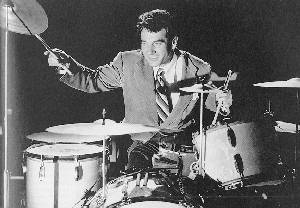Gene Krupa

Gene Krupa was born in 1909 the youngest of nine children. He took up drums at age 11 because they were the cheapest instrument at the music store where he worked.
He moved to New York in 1929 where he joined a pit band for the George Gershwin play Strike up the Band. Fellow band members included Glen Miller and Benny Goodman. After working some various gigs, Goodman urged Krupa to leave the pit bands and join his newly forming group, with the promise that they would be a legitimate jazz band. At first, they were relegated to playing dance tunes until Goodman finally cut loose (see Goodman's biography for more details). In 1938, the Goodman Orchestra became the first jazz group to play at New York's Carnegie Hall and Krupa's drum solo on the song Sing, Sing, Sing considered by many to be the first extended drum solo in jazz. Krupa became known as the father of the jazz drum solo, and his popularity grew to the point where audiences wanted him to solo on every song. This created tension between Goodman and Krupa because Goodman did not want to be upstaged by one of his sidemen.
Krupa left Goodman's Orchestra in 1938 and formed his own big band. He also authored the book The Gene Krupa Drum Method and began an annual drum contest with Louis Bellson winning the first contest. He also became a matinee idol with his work in the movies Beat the Band and Some Like it Hot. After serving 3 months for a bogus drug charge, he reformed his big band in the early 40s and introduced elements of bebop into his music. While many big bands couldn't remain financially afloat as bebop grew in popularity, Krupa managed to keep his full big band together up until 1950 and then toured with a smaller group.
He was signed on for the Jazz at the Philharmonic all-star jam series in the 1950s which featured many famous drum battles with Buddy Rich. In 1954, he co-founded the Krupa-Cole Drum School. In 1959, a movie about his life was made, The Gene Krupa Story, in which Krupa provided the drums on the soundtrack and actor Sal Mineo played Krupa. The resurgence of popularity got him out of teaching and back to performing, however, health problems, including a heart attack in 1960, forced him into early retirement.
A few years later, he came back and joined a re-formed Goodman quartet and toured until his health problems came back. He became an anti-drug lecturer and performed drum clinics. He came back in 1970 and played until he died in 1973 of a heart attack.
Besides bringing the drums to the forefront as a soloing instrument, he also single-handedly built the success of the Slingerland Drum Company. In 1936, he convinced the owner to create a tunable tom-tom. The previous toms had drum heads hard-fastened to the drum, unable to adjust it. He also worked with the Zildjian cymbal company to create the modern high-hat.
For more information on Gene Krupa, check out these sites:
The Gene Krupa Reference Page
- a very well done tribute to Gene Krupa.
America's Ace Drummer Man - A fan's tribute
